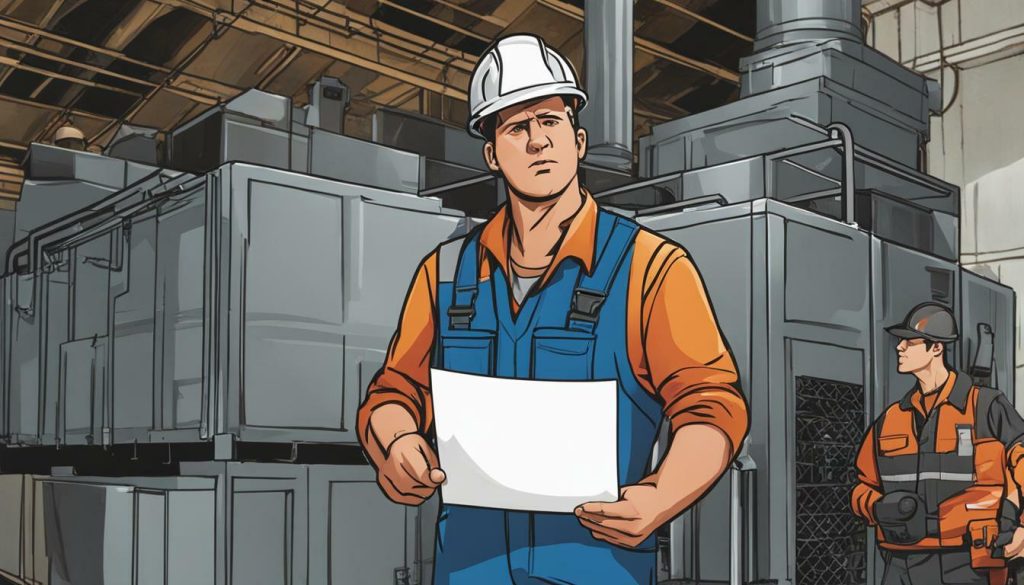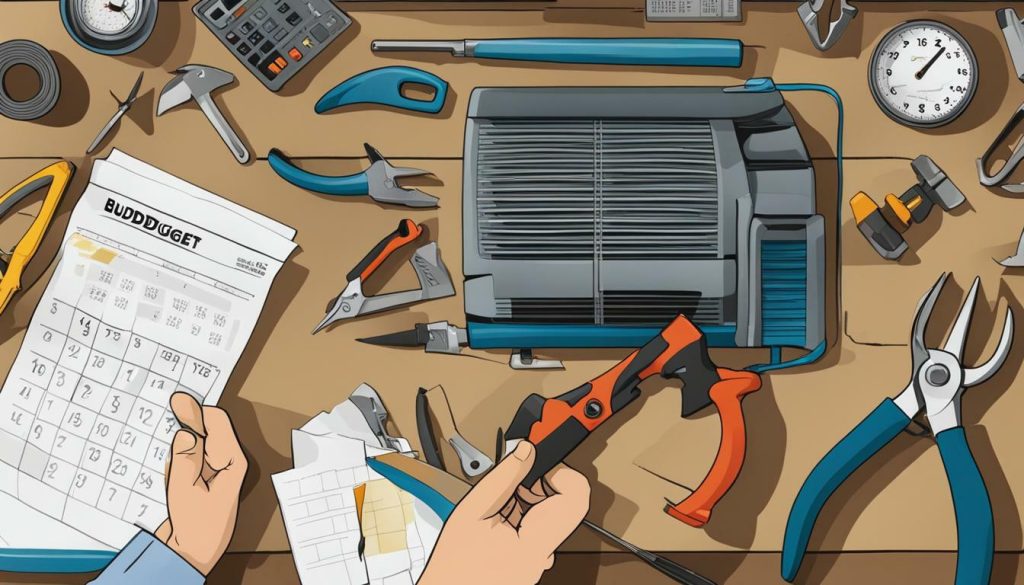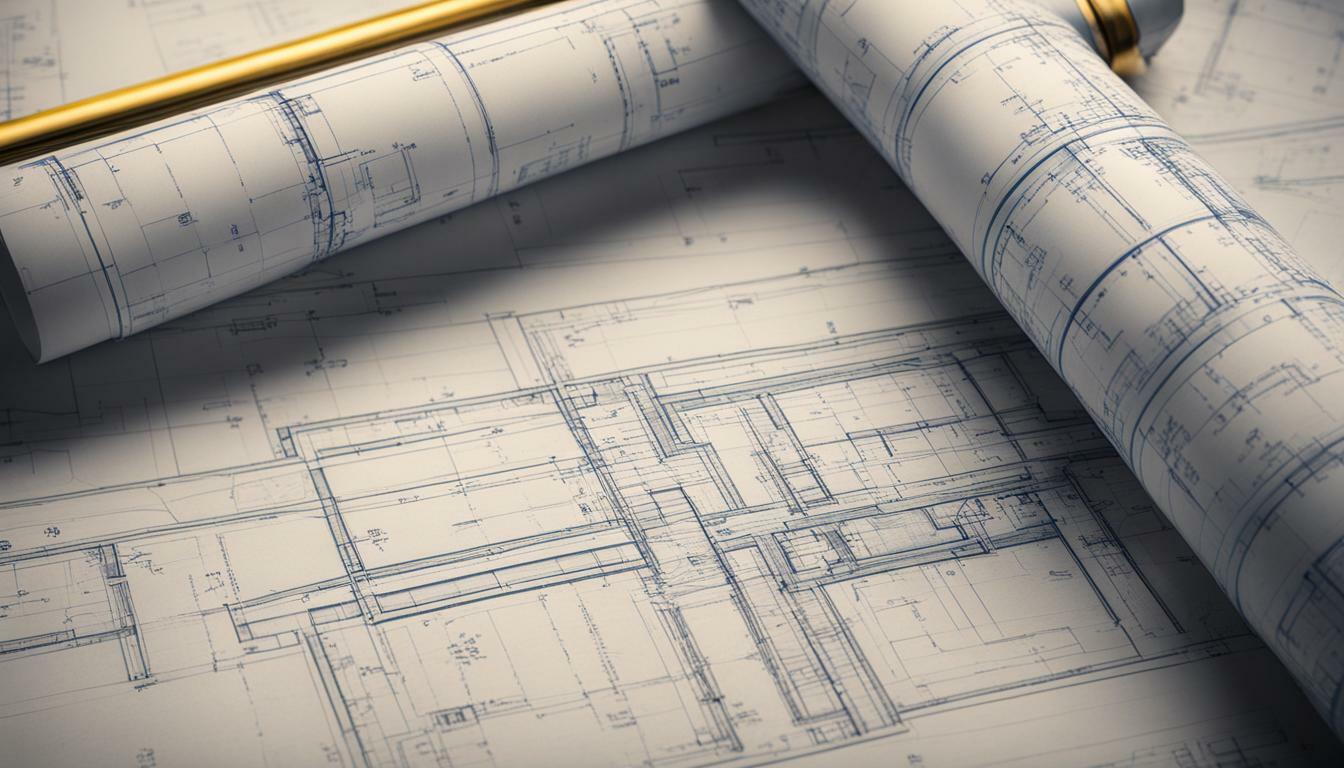Managing changes and amendments in HVAC projects is a crucial task that requires following a standardized change order process and ensuring that all necessary steps are carried out. These projects involve complex systems and require careful planning to ensure the successful execution of modifications. From addressing HVAC system modifications to handling HVAC renovations and alterations, it is essential to navigate project changes effectively.
When it comes to managing changes and amendments in HVAC projects, it is important to have a structured approach. By following a standardized change order process, you can ensure consistency and streamline the management of project changes. From the initial proposal to the final sign-off, each step plays a crucial role in maintaining project integrity and minimizing disruption.
Key Takeaways:
- Following a standardized change order process is vital for managing HVAC project changes effectively.
- Meeting with stakeholders is essential to discuss proposed changes and reach agreements on their impact.
- Defining the change and assessing its impact on the budget and schedule is crucial for successful project management.
- Proper documentation and communication are necessary for presenting and formalizing change orders.
- Negotiation may be required to resolve disagreements or discrepancies regarding project changes.
The Importance of Standardized Change Order Process
Utilizing a standardized change order process is essential when managing changes and amendments in HVAC projects. It provides a consistent framework and ensures that all necessary steps are followed to effectively navigate project changes. By implementing a standard process and template, you can streamline the change order workflow and minimize potential complications.
A standardized change order process offers numerous benefits. Firstly, it promotes consistency in documenting and tracking project changes, making it easier to manage and evaluate their impact. This structured approach also helps to prevent miscommunication and ensures that all parties involved understand the proposed modifications.
By following a standardized change order process, you can maintain transparency and accountability throughout the project. This includes convening meetings with stakeholders to discuss proposed changes and reaching agreements on their impact. Effective communication and collaboration are key to successfully managing HVAC project changes and amendments.
| Benefits of Standardized Change Order Process |
|---|
| Consistency in documenting and tracking project changes |
| Prevention of miscommunication |
| Transparency and accountability |
| Efficient communication and collaboration with stakeholders |
Example of a Standardized Change Order Process
1. Identify the proposed change or amendment in the HVAC project.
2. Analyze the impact of the change on the budget and schedule.
3. Schedule a meeting with relevant stakeholders to discuss the proposed change and reach an agreement on its impact.
4. Document the change order using a standardized template.
5. Present the change order to the other party for formalization and obtain sign off from all parties involved.
6. Update the project schedule to reflect the approved change.
7. Communicate the change to all stakeholders to ensure everyone is aware of the modifications and their potential impact.
8. Keep a comprehensive record of the change order for future reference.
By adhering to a standardized change order process, you can effectively manage changes and amendments in HVAC projects, ensuring smooth execution and successful project outcomes.

Meeting with Stakeholders and Reaching Agreements
Effective management of HVAC project changes involves meeting with stakeholders to discuss proposed modifications and reaching agreements on their implications. These meetings are crucial for ensuring that all parties involved have a clear understanding of the proposed changes and their potential impact on the project.
During these meetings, it is important to have open and transparent communication, allowing all stakeholders to express their concerns, suggestions, and expectations regarding the modifications. This collaborative approach fosters a sense of shared responsibility and accountability, paving the way for successful project outcomes.
| Key Points | Actions |
|---|---|
| Define the proposed change | Clearly articulate the nature and scope of the modification, ensuring that all stakeholders are on the same page. |
| Assess the impact on budget and schedule | Evaluate the financial and time implications of the change, considering factors such as material costs, labor requirements, and potential delays. |
| Reach an agreement | Negotiate and find common ground, taking into account the interests and priorities of all stakeholders. Document the agreed-upon modifications in a change order. |
By engaging in these meetings and reaching agreements, you can minimize the risk of misunderstandings, conflicts, and delays arising from unplanned modifications. This proactive approach ensures that changes are properly assessed, documented, and integrated into the project plan, resulting in improved project outcomes and client satisfaction.

Defining Change and Impact on Budget and Schedule
When managing changes and amendments in HVAC projects, it is crucial to clearly define the proposed change and assess its impact on the budget and schedule. This step is essential for successful project management, as it allows for informed decision-making and ensures that the project remains on track.
Defining the change involves accurately identifying and describing the modifications required in the HVAC system. This includes specifying the scope of work, detailing the necessary alterations, and documenting any additional materials or resources needed. By clearly defining the change, all parties involved can have a clear understanding of what needs to be done.
Assessing the impact on the budget and schedule is equally important. This entails evaluating the financial implications of the proposed change, such as material costs, labor expenses, and any potential changes to the project timeline. By conducting a thorough analysis, project managers can determine if the change is feasible within the allocated budget and if it will cause any delays to the project schedule.
| Key Considerations | Impact |
|---|---|
| Material Costs | Increased or decreased expenses |
| Labor Expenses | Additional labor hours or savings |
| Project Timeline | Potential delays or adjustments |
By assessing the impact on the budget and schedule, project managers can make informed decisions and communicate effectively with all stakeholders. This ensures that the proposed change aligns with the project’s goals and objectives, while also considering any financial and time constraints. Ultimately, a clear understanding of the change and its impact on the budget and schedule is crucial for successful HVAC project management.

Presenting and Formalizing the Change Order
Presenting the change order to the other party and formalizing it is a critical step in managing HVAC project changes effectively. This ensures that all parties involved are aware of the proposed modifications and have the opportunity to review and provide their input. By having a formalized change order, you can establish a clear record of the agreed-upon changes and avoid any misunderstandings or disputes in the future.
To present the change order, schedule a meeting with the relevant stakeholders, including the client, project manager, and any other parties directly impacted by the proposed modifications. During the meeting, clearly explain the nature of the change, its impact on the project’s budget and schedule, and any additional considerations that need to be addressed.
Once the other party has had the opportunity to review and discuss the proposed change, it is important to obtain their sign-off and formalize the agreement. This can be done by preparing a change order document that includes all the necessary details, such as the date, description of the change, associated costs, and revised schedule. Ensure that all parties involved carefully review and approve the change order before it is officially implemented.
| Date | Description | Cost | Revised Schedule |
|---|---|---|---|
| MM/DD/YYYY | Description of the change | Cost of the change | Revised project schedule |

Example Change Order
Here is an example of what a change order document may look like:
Date: Insert the date of the change order
Description: Provide a detailed description of the change
Cost: Specify the cost associated with the change, including any additional labor, materials, or equipment expenses
Revised Schedule: Outline the impact of the change on the project’s timeline, including any adjustments to milestones or completion dates
By following a standardized process for presenting and formalizing change orders, HVAC project changes can be effectively managed, ensuring that all parties are informed, aligned, and ready to proceed with the agreed-upon modifications. With proper documentation and clear communication, potential issues and delays can be minimized, allowing for a successful project outcome.
Negotiating Further if Needed
In some cases, further negotiation may be necessary when managing HVAC project changes to resolve disagreements or discrepancies. Open communication and a willingness to compromise are key in finding mutually beneficial solutions.
When faced with conflicting viewpoints or differing interpretations of proposed changes, it is essential to gather all relevant stakeholders and engage in productive discussions. This ensures that everyone’s concerns and perspectives are heard and taken into account.
During the negotiation process, a focus on finding common ground and exploring alternative options can help bridge any gaps and reach agreements. It is important to approach these discussions with an open mind and a willingness to explore creative solutions that address the needs and interests of all parties involved.
Ultimately, the goal of negotiation is to find a resolution that satisfies both the project’s objectives and the concerns of the stakeholders. By maintaining open lines of communication, seeking common ground, and fostering a collaborative environment, successful negotiations can be achieved, leading to the effective management of HVAC project changes.

Verifying Impact and Updating the Schedule
After obtaining necessary approvals, it is crucial to verify the impact of changes and update the project schedule accordingly in HVAC projects. This step ensures that all modifications are seamlessly integrated, minimizing the risk of delays or disruptions. By thoroughly assessing the impact, you can effectively plan and allocate resources to accommodate the changes.
One effective approach is to create a table that outlines the specific changes and their corresponding impact on the budget and schedule. This visual representation allows for easy reference and helps stakeholders understand the implications. Additionally, consider using bullet points to highlight key information, such as the revised timeline, cost adjustments, and any potential risks or dependencies. This concise format helps keep everyone informed and allows for efficient decision-making.
Once the impact has been determined, it is essential to update the project schedule accordingly. This ensures that all team members are aware of the new timeline and can adjust their tasks and priorities accordingly. By communicating these changes in a clear and timely manner, you can maintain transparency and avoid any potential confusion or misunderstandings.

Sample Table: Impact of Changes on Budget and Schedule
| Change Description | Impact on Budget | Impact on Schedule |
|---|---|---|
| Installation of additional HVAC unit | + $10,000 | + 1 week |
| Change in equipment supplier | – $5,000 | No change |
| Alterations to ductwork layout | + $2,500 | + 3 days |
Communicating the Change to Stakeholders
Effective communication plays a vital role in managing HVAC project changes, and it is essential to inform all stakeholders about the approved modifications. By keeping stakeholders informed, you ensure that everyone involved understands the changes and their impact on the project. Clear and timely communication helps to avoid misunderstandings, reduces the risk of errors, and promotes a collaborative approach to managing project changes.
One effective way to communicate the change to stakeholders is through regular project update meetings. These meetings provide an opportunity to present the change order, explain the reasons behind the modification, and address any concerns or questions raised by stakeholders. By fostering open dialogue and allowing for feedback, you can ensure that all parties are on the same page and working towards a common goal.
Another important aspect of communicating the change is to provide written documentation. This can include official change order forms, project memos, or email updates. By documenting the change and sharing it with stakeholders, you create a record of the modification, which can be referred to later if needed. It also helps to ensure that all parties have a clear understanding of the change and can refer back to the documentation as a point of reference.
Example of a Change Order Communication:
Dear [Stakeholder Name],
We would like to inform you that a change order has been approved for the HVAC project currently underway. The change involves the modification of the ventilation system in order to address specific airflow requirements outlined by the client. This change will impact the budget and schedule of the project, and we wanted to ensure that all stakeholders are aware of the approved modifications.
Please find attached the official change order form, which provides detailed information about the change, including the reasons for the modification and its impact on the project. We would appreciate it if you could review the document and provide us with any feedback or questions you may have. We are committed to ensuring that all parties are involved and informed throughout the process.
Should you have any further inquiries or require additional clarification, please do not hesitate to contact us. We appreciate your cooperation and look forward to working together to successfully implement this change.
Best regards,

| Key Points | Benefits |
|---|---|
| Regular project update meetings | Builds understanding and collaboration among stakeholders |
| Written documentation | Creates a record of the modification and serves as a point of reference |
| Clear and timely communication | Reduces the risk of errors and misunderstandings |
Keeping Good Records of Change Orders
Maintaining comprehensive records of change orders is crucial when managing HVAC project changes, ensuring legal compliance and facilitating future reference. These records serve as a valuable documentation resource that helps track the history of modifications made to the project, including the reasons for the changes, the approval process, and the impact on the budget and schedule.
By keeping detailed records, you can effectively manage any disputes or claims that may arise during or after the completion of the project. These records provide evidence of the agreed-upon changes, ensuring that all parties involved are held accountable for their obligations.
In addition, maintaining accurate records of change orders is essential for legal compliance. Regulatory bodies often require documentation of any changes or modifications made to HVAC systems. By having a well-organized record-keeping system, you can easily demonstrate compliance with relevant regulations and codes.
Furthermore, having a comprehensive record of change orders enables you to learn from past experiences and improve future project management practices. By analyzing the patterns and trends in project changes, you can identify areas for improvement, implement preventive measures, and enhance overall project efficiency and effectiveness.
| Benefits of Keeping Good Records of Change Orders: |
|---|
|

Example of a Change Order Record
| Change Order Number | Date | Description of Change | Reason for Change | Approved By |
|---|---|---|---|---|
| CO-001 | March 15, 2022 | Replacement of HVAC unit with a higher capacity model | Increase cooling efficiency to meet client’s needs | Project Manager |
| CO-002 | April 2, 2022 | Modification of ductwork layout | Optimize airflow distribution | Architect and HVAC Engineer |
Considering Regulations and Codes
When managing changes and amendments in HVAC projects, it is essential to consider and comply with relevant regulations and codes. These regulations are put in place to ensure the safety, efficiency, and compliance of HVAC systems with industry standards. Failure to adhere to these regulations can result in costly fines, legal issues, and potential risks to the health and safety of occupants.
One important aspect to consider is obtaining the necessary permits and approvals from local authorities before making any changes to the HVAC system. This ensures that the proposed modifications align with local building codes and regulations. Building codes often include specifications for system design, installation, maintenance, and operation, and it is crucial to follow these requirements to maintain compliance.
In addition to building codes, there may also be specific industry regulations and standards that need to be considered. For example, the Environmental Protection Agency (EPA) has regulations in place to protect the environment and promote energy efficiency. These regulations may dictate requirements for refrigerant management, energy consumption, and emissions.

By considering and complying with relevant regulations and codes, HVAC professionals can ensure that their project changes are in line with industry best practices and legal requirements. This not only safeguards the integrity of the HVAC system but also protects the interests of all stakeholders involved.
| Benefits of Considering Regulations and Codes |
|---|
| Ensures safety and health compliance |
| Protects the environment and promotes energy efficiency |
| Prevents costly fines and legal issues |
| Maintains integrity and performance of the HVAC system |
Conclusion
Effectively managing changes and amendments in HVAC projects requires a standardized change order process, clear communication, and comprehensive documentation. By following a standardized process, you can ensure consistency and structure when dealing with project changes. This includes using a standard template for change orders to make the process more efficient and organized.
Meeting with stakeholders and reaching agreements on proposed changes is essential for successful project management. By involving all relevant parties in discussions and decision-making, you can address any concerns or potential impacts on the project. Clear communication is crucial throughout the process to ensure everyone is informed and on the same page.
Defining the proposed change and clarifying its impact on the budget and schedule is vital for effective planning and resource allocation. Accurately assessing the financial and time implications of modifications will help you make informed decisions and avoid any disruptions or delays.
Presenting the change order to the other party and formalizing it through proper documentation is important to ensure that both parties are in agreement and committed to the proposed modifications. Negotiating further, if needed, allows for open communication and compromise to reach mutually beneficial solutions.
FAQ
What is the importance of following a standardized change order process in HVAC projects?
By following a standardized change order process, you ensure consistency and efficiency in managing project changes. It allows for clear communication, proper documentation, and effective resolution of any disputes or discrepancies.
Why is it necessary to meet with stakeholders and reach agreements when discussing HVAC project changes?
Meeting with stakeholders and reaching agreements is crucial to ensure that all parties understand the proposed changes and their impact. It promotes collaboration, consensus, and effective decision-making throughout the project.
How do you define a change and assess its impact on the budget and schedule in HVAC projects?
Defining a change involves accurately identifying the modifications required and evaluating their financial and time implications. This assessment ensures that the project remains within budget and adheres to the established timeline.
What is the process for presenting and formalizing a change order in HVAC projects?
The process involves presenting the change order to the other party for formalization. This includes proper documentation, obtaining signatures and approvals from all parties involved, and ensuring that the change is properly integrated into the project plan.
What should be done if there are disagreements regarding proposed changes in HVAC projects?
If there are disagreements, further negotiation should take place. This involves open communication, compromise, and finding mutually beneficial solutions to resolve any discrepancies and move forward with the project.
Why is it important to verify the impact of approved changes and update the project schedule?
Verifying the impact of approved changes ensures that they are successfully implemented without causing delays or disruptions. Updating the project schedule helps in managing resources, coordinating activities, and keeping the project on track.
How should approved changes be communicated to stakeholders in HVAC projects?
Approved changes should be communicated clearly and timely to all relevant stakeholders. This includes providing detailed information on the modifications, their rationale, and any potential impact on the project’s timeline, budget, and scope.
Why is it necessary to keep good records of change orders in HVAC projects?
Keeping good records of change orders is essential for future reference, legal compliance, and potential dispute resolution. Accurate documentation ensures that all changes are properly recorded and can be easily traced back if needed.
What should be considered in terms of regulations and codes when managing changes in HVAC projects?
It is important to consider any relevant safety, environmental, and building regulations when managing changes in HVAC projects. Compliance with these regulations ensures that the modifications are performed in a legally and ethically responsible manner.





0 Comments